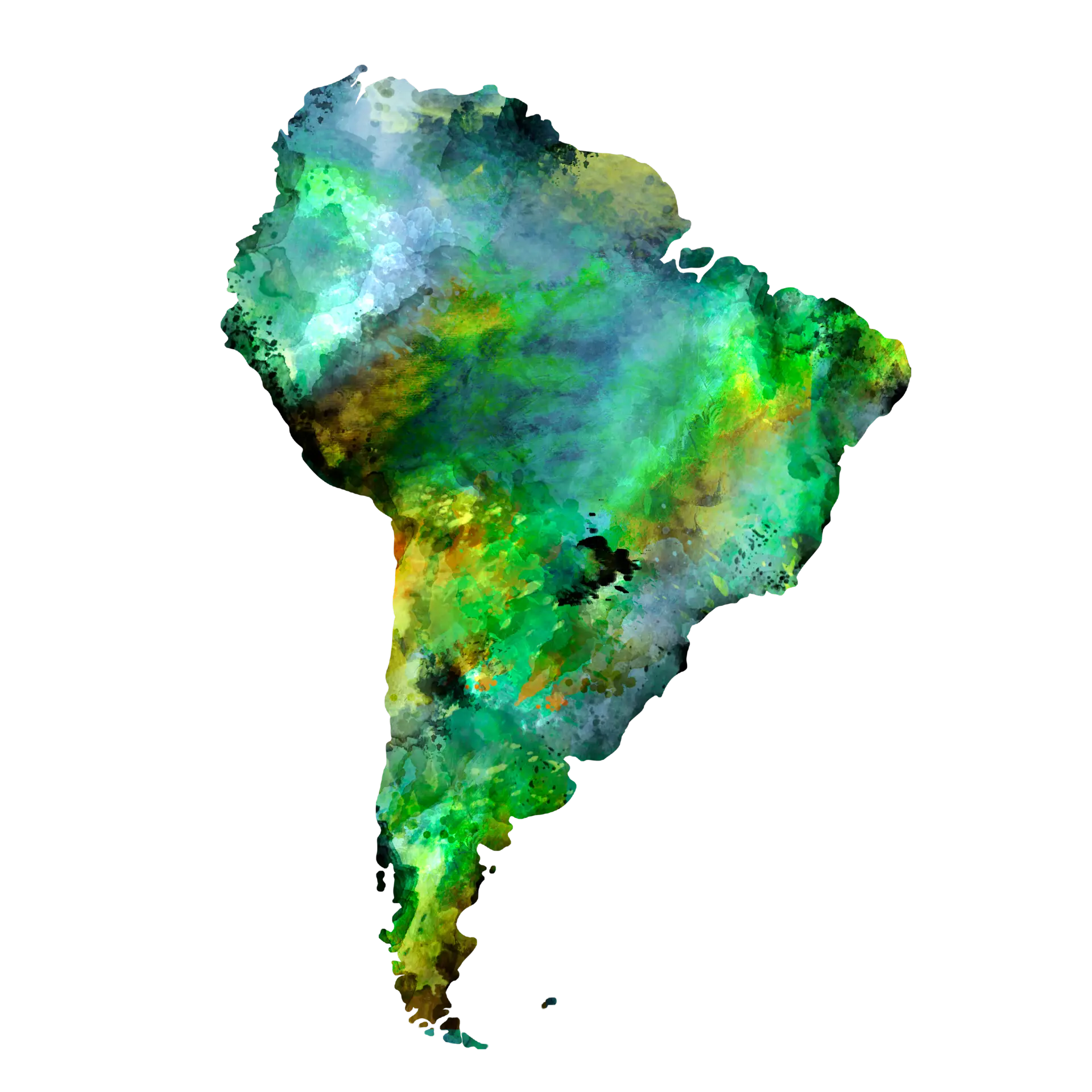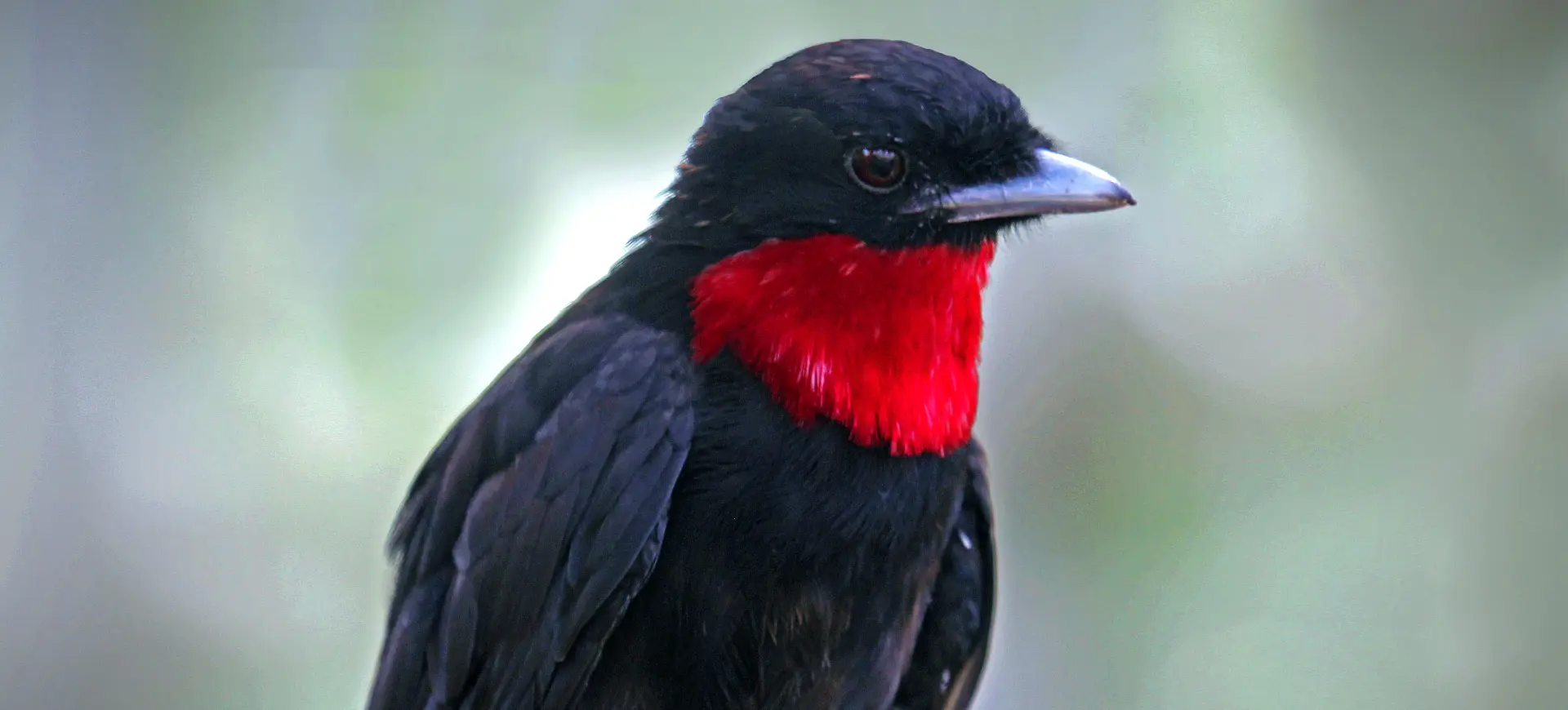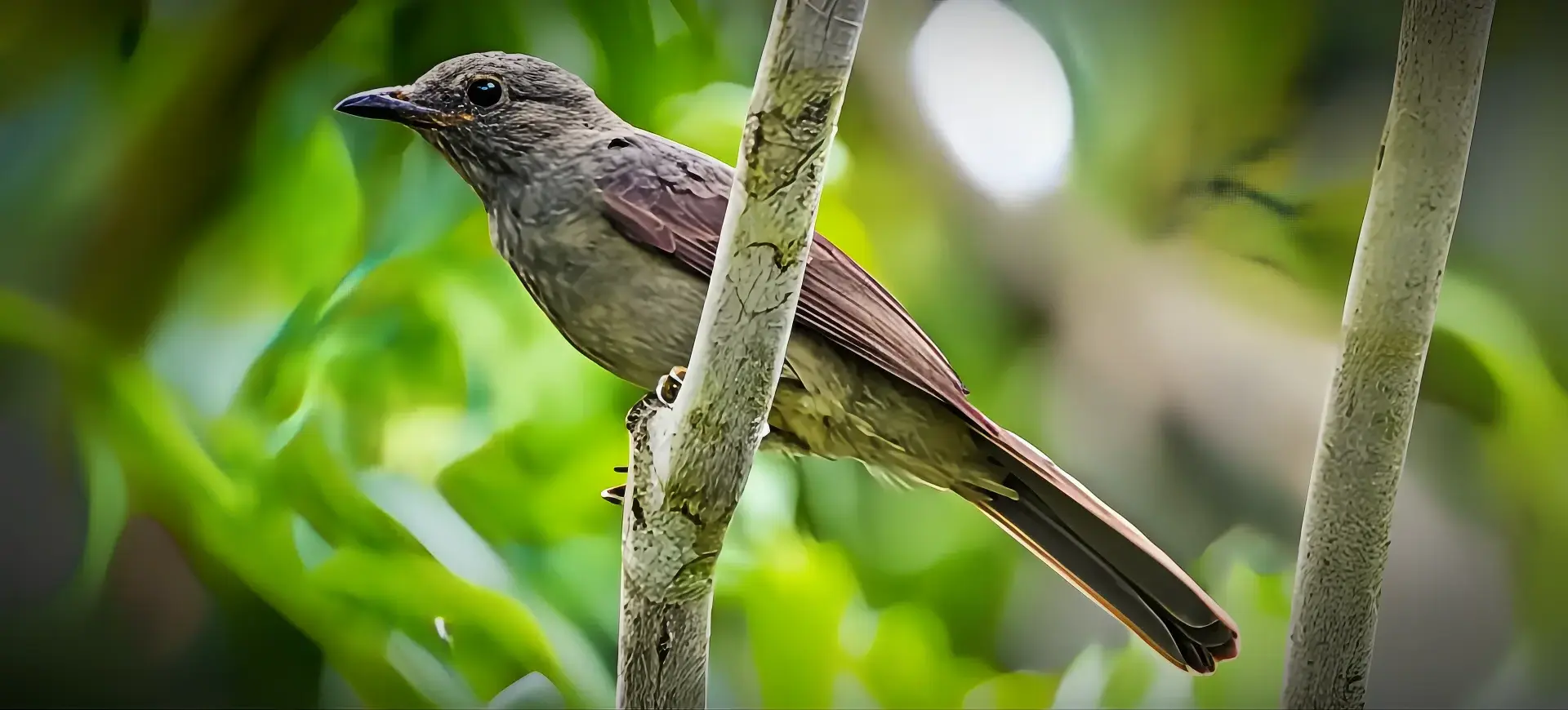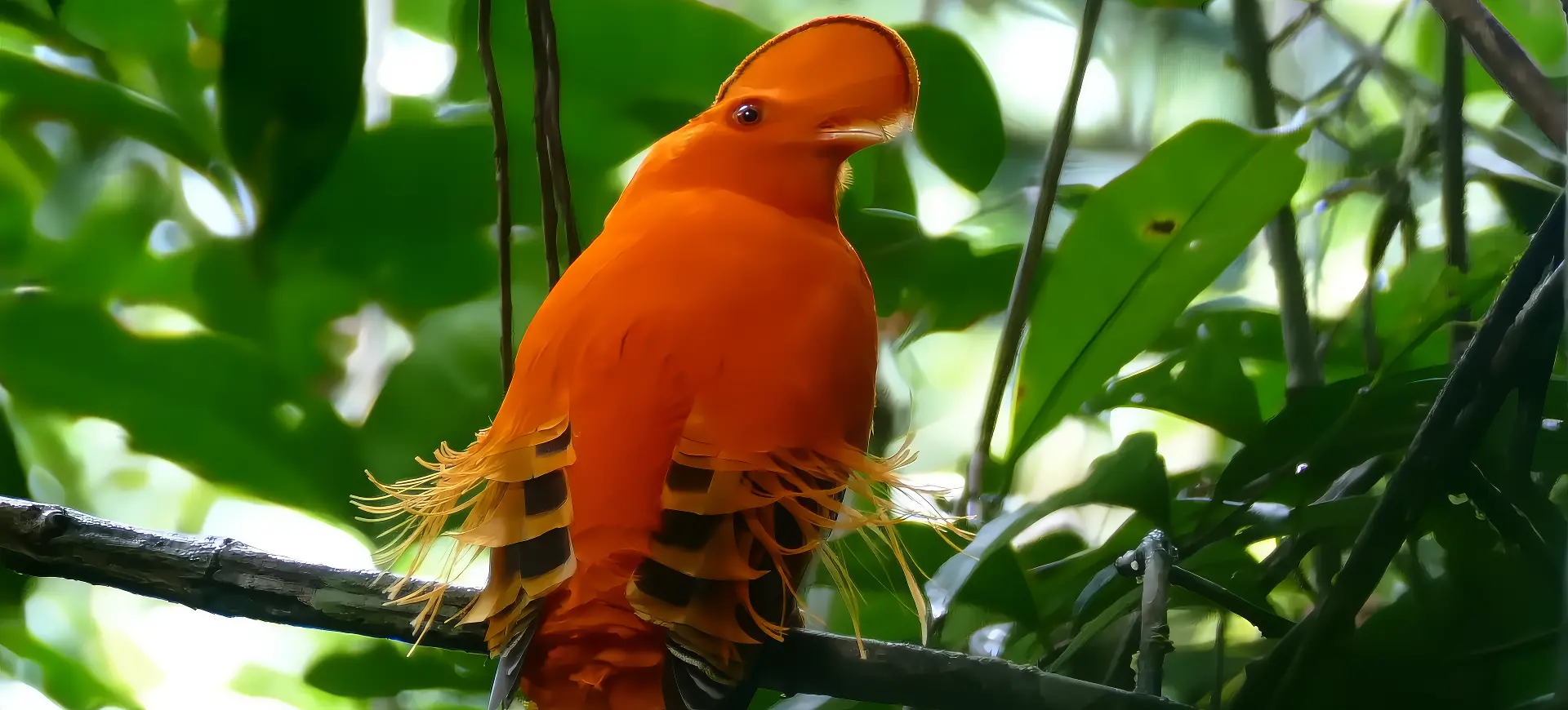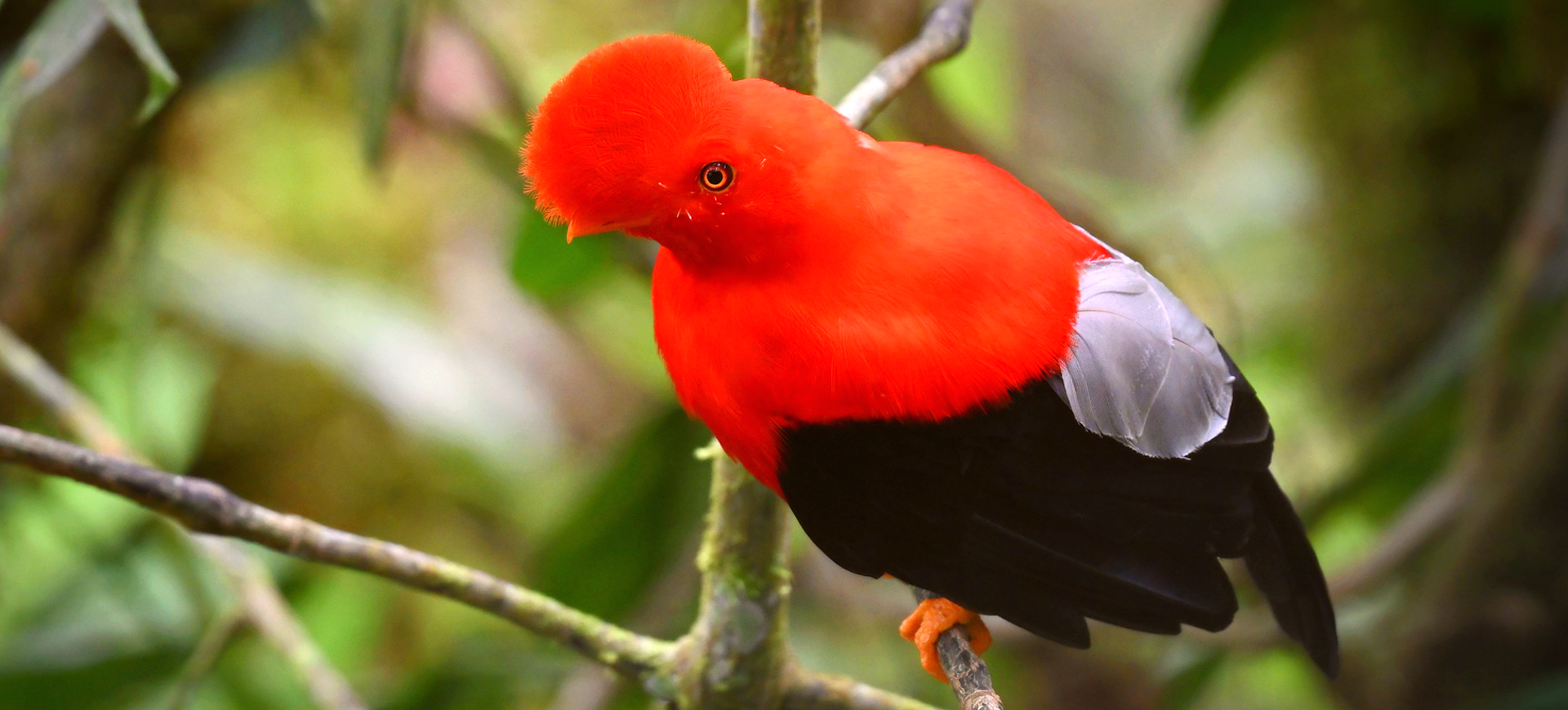Overview
The Guianan Red Cotinga, scientifically known as Phoenicircus Carnifex, is a vibrant and visually striking bird found in the northeastern region of South America. Notable for its deep crimson plumage and black wings, it is a species that captures attention for its rarity and stunning appearance. This bird is a member of the Cotingidae family, famous for its colorful and diverse species. The Guianan Red Cotinga prefers the dense, humid forest canopies of the Amazon Basin, making it a species associated with rich, undisturbed habitats.
The male Guianan Red Cotinga is especially conspicuous due to its bright red coloration, which is used to attract females during the mating season through various displays and vocalizations. Females, in contrast, are not as brightly colored, which provides them with better camouflage against the forest background, crucial for nesting and raising young. This dimorphism is typical of many bird species where males must be visible to compete for mates, while females must avoid predators. The Guianan Red Cotinga’s diet primarily consists of fruits, which it forages in the canopy.
Despite its striking appearance, the Guianan Red Cotinga remains a poorly understood species due to its elusive nature and the remote locations it inhabits. It is rarely seen, often only briefly glimpsed by birdwatchers and researchers. The bird’s preference for high canopy layers and its low-density populations make it a challenging subject for study. This lack of data hampers conservation efforts, but it is presumed that habitat loss and degradation threaten its survival.
Taxonomy
Kingdom
Phylum
Class
Order
Family
Genus
Species
Type
Current distribution:
The Guianan Red Cotinga is distributed across several countries in northeastern South America, including Guyana, Suriname, French Guiana, and northern parts of Brazil. Its presence is highly localized, with populations concentrated in areas with extensive tracts of primary rainforest. The bird's range is closely tied to the health and extent of these forested areas.
Despite its limited range, the Guianan Red Cotinga can maintain viable populations with optimal habitat conditions. However, the ongoing threat of habitat loss due to logging, mining, and agricultural expansion continues to risk its survival. Conservation measures that protect large forest areas are essential to ensure the future of this spectacular bird.
Physical Description:
The Guianan Red Cotinga is primarily known for its dazzling red plumage, which covers most of its body except for its dark black wings and tail. The intensity of the red coloration makes it one of the most visually impressive birds in its habitat. Adult males are particularly vibrant, which serves as a visual signal to females and rivals. The contrast between the red body and black wings is beautiful and quite unusual among the cotingas.
Females and juveniles are less colorful, typically displaying a mix of duller red and brown shades, which helps them blend into the forest canopy. This sexual dimorphism is typical for the species, with males displaying more prominent colors to attract mates. The bird’s overall body structure is robust, with a strong, short beak adapted for fruit consumption. Its size and shape are optimized for life in the dense upper canopy, where agility and visibility are key.

Lifespan: Wild: ~10 Years || Captivity: ~12 Years

Weight: Male & Female: 2.7-2.8 oz (77-80 g)

Length: Male & Female: 7.5-8 in (19-20.5 cm)
Characteristic:
Native Habitat:
The Guianan Red Cotinga’s native habitat is primarily the tropical rainforests of the Guiana Shield in South America. These forests are characterized by high biodiversity and complex canopy structures, providing the ideal environment for this species. The bird is mostly found in undisturbed or minimally disturbed forests, where it lives in the upper canopy layers, rarely descending to the ground.
The Guianan Red Cotinga’s preference for dense, mature forests makes it particularly susceptible to deforestation and habitat fragmentation. Preserving its habitat is crucial for maintaining the species’ population, which is naturally low in density. Efforts to protect these areas are vital for the conservation of the Guianan Red Cotinga and the myriad other species that share its environment.
Climate Zones:
Biomes:
WWF Biomes:
Biogeographical Realms:
Continents:
Diet:
Diet & Feeding Habits:
The Guianan Red Cotinga’s diet is predominantly frugivorous, relying heavily on the fruits found in the canopy of its rainforest habitat. This diet is supplemented by occasional insects, which provide protein and other nutrients necessary for its health. The bird’s feeding strategy involves foraging alone or in pairs, using its strong beak to pluck fruits from branches. Its preference for high canopy layers allows it to access food sources that are less available to other forest dwellers.
Regarding feeding behavior, the Guianan Red Cotinga is not only a fruit consumer but also plays a vital role in seed dispersal. Consuming fruits and excreting the seeds away from the parent plant helps regenerate its forest environment. This ecological role is crucial for the maintenance of forest health and diversity. The bird’s ability to move its different areas also aids in the genetic diversity of the plant species it feeds on.
Mating Behavior:
Mating Description:
The Guianan Red Cotinga’s mating behavior involves elaborate displays by the male to attract a mate. These displays include vocalizations and physical posturing, highlighting the male’s vibrant plumage. The bright red color serves as a signal to females, who choose mates based on the intensity and quality of the coloration and the display. This selection process ensures that only the most fit males reproduce, thus driving the evolution of the species’ striking appearance.
Nesting is a solitary affair, with the female constructing the nest and caring for the eggs and young alone. This behavior allows the male to continue displaying to attract additional mates if possible. The nesting sites are typically high in the canopy, hidden among dense foliage to protect against predators. The reproductive success of the Guianan Red Cotinga is closely linked to the availability of food and the quality of the habitat, which influences all aspects of their breeding ecology.
Reproduction Season:
Birth Type:
Pregnancy Duration:
Female Name:
Male Name:
Baby Name:
Social Structure Description:
The Guianan Red Cotinga is a solitary bird for most of the year, only coming together with others during the breeding season. Outside of breeding, individuals maintain territories they defend from others of the same species. This territorial behavior ensures that each bird can access sufficient food resources throughout the year.
During the breeding season, the social dynamics change as males become more visible and vocal to attract mates. The interaction between males and females is primarily based on mating rituals, with little to no cooperation outside of these activities. This species’ solitary nature is typical of many forest-dwelling birds, where resources are scattered, and competition can be intense.
Groups:
Conservation Status:
Population Trend:
The population of the Guianan Red Cotinga is decreasing, primarily due to habitat loss and degradation. The exact numbers are difficult to ascertain due to the bird’s elusive nature and the remote locations it inhabits. These factors challenge efforts to monitor and assess the population, making it hard to develop effective conservation strategies.
The main threat to this species is the ongoing destruction of its rainforest habitat. Logging, mining, and agricultural expansion are reducing the extent and quality of the forests on which this bird depends. Protecting these habitats is crucial for the Guianan Red Cotinga’s survival and the countless other species that share its environment.
Population Threats:
The primary threats to the Guianan Red Cotinga include deforestation and habitat fragmentation. The destruction of tropical rainforests for timber, mining, and agricultural expansion directly impacts the species by reducing available habitat and food sources. This habitat loss decreases population sizes and isolates remaining groups, hindering gene flow and increasing vulnerability.
Other threats include hunting and the illegal pet trade, although these are less significant than habitat destruction. The bird’s striking appearance makes it a target for collectors, although its rarity and the difficulty of accessing its habitat limit this threat. To address these issues, increased awareness and enforcement of wildlife protection laws are needed.
Conservation Efforts:
Conservation efforts for the Guianan Red Cotinga are focused on habitat preservation and the creation of protected areas. These measures are crucial for maintaining the large tracts of undisturbed forest that this species requires. Environmental laws and regulations preventing deforestation and habitat degradation are key to these conservation strategies.
Additionally, international cooperation is necessary to manage and protect the transboundary habitats across the Guianan Shield. Research and monitoring programs are also important to better understand the species’ ecology, distribution, and population trends. These efforts help inform and improve conservation actions, ensuring they are effective and appropriately targeted.
Additional Resources:
Fun Facts
- The Guianan Red Cotinga is one of the few bird species where the male is entirely red.
- It is part of the Cotingidae family, which includes some of the world’s most colorful and unusual birds.
- The species is known for its elusive behavior, making it a rare sight even for avid birdwatchers.
- They are important contributors to their ecosystems as dispersers of fruit seeds.
- The Guianan Red Cotinga’s vibrant red color is due to pigments in the fruits it consumes.
- Males can be polygynous, attempting to mate with multiple females in one season.
- Their habitat, the tropical rainforests of the Guiana Shield, is among the most biodiverse in the world.
- Conservation efforts are critical due to their dependence on large, undisturbed forest areas.
- The bird’s name, “Carnifex,” translates to “butcher” in Latin, contrasting sharply with its stunning appearance.
- Despite its beauty, the Guianan Red Cotinga is rarely kept in captivity due to its specific habitat needs and diet.

